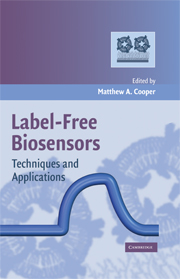Book contents
- Frontmatter
- Contents
- Contributors
- Preface
- LABEL-FREE BIOSENSORS
- 1 Label-free optical biosensors: An introduction
- 2 Experimental design
- 3 Extracting affinity constants from biosensor binding responses
- 4 Extracting kinetic rate constants from binding responses
- 5 Sensor surfaces and receptor deposition
- 6 Macromolecular interactions
- 7 Interactions with membranes and membrane receptors
- 8 Application of SPR technology to pharmaceutical relevant drug-receptor interactions
- 9 High-throughput analysis of biomolecular interactions and cellular responses with resonant waveguide grating biosensors
- 10 ITC-derived binding constants: Using microgram quantities of protein
- 11 Electrical impedance technology applied to cell-based assays
- Index
- Plate section
1 - Label-free optical biosensors: An introduction
Published online by Cambridge University Press: 05 May 2010
- Frontmatter
- Contents
- Contributors
- Preface
- LABEL-FREE BIOSENSORS
- 1 Label-free optical biosensors: An introduction
- 2 Experimental design
- 3 Extracting affinity constants from biosensor binding responses
- 4 Extracting kinetic rate constants from binding responses
- 5 Sensor surfaces and receptor deposition
- 6 Macromolecular interactions
- 7 Interactions with membranes and membrane receptors
- 8 Application of SPR technology to pharmaceutical relevant drug-receptor interactions
- 9 High-throughput analysis of biomolecular interactions and cellular responses with resonant waveguide grating biosensors
- 10 ITC-derived binding constants: Using microgram quantities of protein
- 11 Electrical impedance technology applied to cell-based assays
- Index
- Plate section
Summary
INTRODUCTION
The ability to study interactions among biomolecules, to observe the activity of cells, and to detect analytes specifically from bodily fluids, manufacturing processes, or environmental samples are cornerstones of life science research, pharmaceutical discovery, medical diagnosis, and food/water safety assurance. These capabilities and many others are enabled by the ability to perform biochemical and cell-based assays that allow scientists to ask basic questions about whether one analyte interacts with another, how strong the binding affinity is between two proteins, whether a chemical compound will affect the proliferation rate of cancer cells, and the concentration of a biomarker for cancer within a patient's blood sample. The development of technology to meet these requirements is challenging because biochemical analytes, which can include drug compounds with molecular weights below 500 Da, DNA oligomers, peptides, enzymes, anti-bodies, and viral particles, are exceedingly small and sometimes present within a test sample at concentrations in the fg/ml to pg/ml concentration range that simultaneously contains thousands of other molecules at concentrations orders of magnitude greater. Larger biochemical analytes – such as bacteria, spores, cells, and cell clusters – are less difficult to observe if they can be stained with a colored or fluorescent dye. However, such treatments generally result in the death of the specimen, thus preventing the ability to study a single population repeatedly over a long time period.
- Type
- Chapter
- Information
- Label-Free BiosensorsTechniques and Applications, pp. 1 - 28Publisher: Cambridge University PressPrint publication year: 2009
- 7
- Cited by



